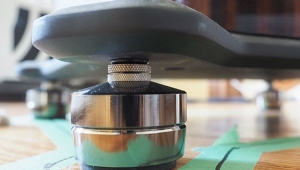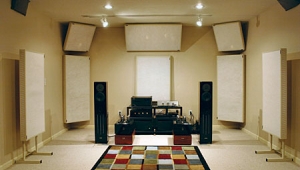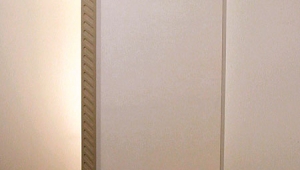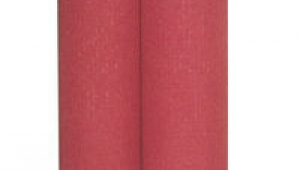| Columns Retired Columns & Blogs |
Acoustic Sciences Corp. Tube Traps Page 2
When sound strikes a flat-surface boundarv, the resulting pressure buildup may he dissipated in two ways: by molecular motion parallel to the boundary surface, and by reflection off the boundary surface. Where two boundaries meet, as in a room corner, one avenue of pressure relief is cut off and more energy must then be reradiated by reflection. Thus, pressure buildups are greater in a corner. Where three surfaces abut, as with floor and ceiling corners, pressure changes are even higher still. This is why loudspeakers placed in room corners will excite every standing wave the room is capable of supporting at maximum efficiency, and why audible bass response is usually greatest in the other room corners. The result is the most bass you can get, but also the most irregular LF response.
Footnote 3: Just before this issue went off to the printer. JGH and I were attempting some critical listening in his "Tubed" listneing roomt—he always has been a rabid tube fan—when he pointed out a surfeit of low end at the back wall right in front of the door. Moving a good-sized tube column in front of the door (thereby blocking off the room's only means of egress) eliminated the problem. These tubes can really change your life!—Larry Archibald
Traditionally, standing waves have been considered an inescapable evil in home sound reproduction, to be worked around as best one could. (The "ideal" room dimension ratios of 1 to 1.25 to 1.6 does not reduce the severity of standing waves; it merely puts them as far from one another as possible, to minimize augmentations and cancellations. By spreading out the irregularities, it also creates the illusion of smooth response.)
ASC's Tube Traps now provide a means for actually suppressing standing waves.
The Tube Trap
Each Trap is a hollow tube with a solid cap on each end. The walls of the tube consist of a 1"-thick layer of dense, fine-stranded fiber-glass, surrounded by a rigid wire frame to prevent its collapse. The outer surface is a decorative fabric material available in a variety of colors.
Placed in a room corner, the tube is subjected to air-pressure variations from standing-wave activity; these create pressure differentials between the room and the cylinder. The porous fiber-glass allows air to flow in and out of the hollow cylinder in order to equalize the pressures; because the fiber-glass is quite dense, friction between the air molecules and the fiber-glass strands tends to impede air flow. The friction results in heat, which draws energy from the moving air—energy that would otherwise have been re-radiated as a standing wave.
Because it takes a certain period of time for the inside and outside pressures to equalize, thc LF absorption characteristic of an ASC tube depends on its internal volume. The larger the volume, the more time required for pressure equalization and the lower the absorption frequencv. The smallest tube, 9" in diameter, works down to around 90Hz. An 11-incher is good down to 45Hz, while a 16-incher is claimed to be effective to 10Hz—not that anyone is likely to care.
Thc end caps on each tube are threaded and metal studs are provided to stack several tubes together, allowing for the assemblv of a stable floor-to-ceiling column. The tubes are light enough so that an 8'stack could fall on your head without causing much more than acute surprise; nevertheess, if you have small children or cats with a penchant for climbing, I would suggest anchoring the columns to the wall or ceiling with a length of picture wire.
I should mention here another interesting feature of the Tube Trap. Suspended just under the surface of each tube, and wrapped around about 180° of its circumference, is a thin sheet of soft plastic that is reflective at frequencies above 400Hz. (It has little effect below 300Hz.) Thus, each tube can be "tuned" by rotating it for the optimum balance between low- and upper-frequency absorption, to compensate for differences in the absorption coefficients of wall surfaces behind it. One can tell at a glance which way the tube is oriented by thc placement of a seam that runs up and down the tube, so this tuning process is not too difficult.
Trying Out the Tube Trap
Like all great inventions, the Tube Trap is a masterpiece of elegant simplicity. What is most remarkable about it, though, is how well it works. Just two of these tubes in the corners behind the loudspeakers made a clearly audible difference in LF smoothness and detail. Floor-to-ceiling columns in all four room corners produced an imrovement that could only be described as dramatic. Additional ones along the walls can make the room as acoustically dead as you want it to be.
While, according to the manufacturer, it is possible to overdamp a room with Traps, I was not able to confirm this: their not-inconsiderable cost—particularlv in the larger diameters—and their tendency to eat up room space will generally dictate using them efficiently rather than going for overkill. Even a minimally efficient room treatment may cost close to $1000, but the onus is partly offset by the fact that you can do the treatment in stages, starting with two of the large Traps in the most critical location, then adding more as finances permit—which is fortunate, considering how expensive complete room treatment is. (The cost of doing my room thoroughly was about $8200 at retail.)
Because the cost of each ASC Trap depends on its size, you should use the smallest ones you can get away with. The 11" tubes will usually be ideal in three-surface corners, with 9-inchers suitable for two-surface junctions and midwall locations. In listening rooms of average size, you should not try to suppress all of the lowest-frequency standing waves, as they will usually be near the speakers' low-end limit, where output level is somewhat down to begin with. It is pointless, for example. to use 20" tubes in a system with loudspeakers whose bottom range doesn't extend below 50Hz.
You might build the treatment of a typical room as follows:
• Single 11-inchers in lower room corners—first behind the speakers. then 16-inchers behind the listening area.
• Go up to the ceiling in the corners with 11-inchers behind the speakers, then more 11-inchers behind the listening area.
• Single 11-inchers at mid-points along the lower side walls.
• Single 9-inchers at one-quarter points along the lower side walls.
• Go up to the ceiling at mid- and quarter-points. (You're now venturing into the realm of no-holds-barred.)
• 9-inchers at all boundary edges, with tubes parallel to the edges. Now you're a complete Tube addict!
Getting Tubed
My listening room was Tube-treated by ASC's Field Rep Sandy Hawkins, who reallv did thc whole number—no holds barred. The room now contains 60 Tubes, 9" to l6" in diameter; to say that it has been transformed would understate the case. With only 1"-thick fiber-glass panels on the walls and carpeting on the floor, this used to be a good listening room. It is now superb! Everything about the sound except high-end quality has improved, and dramatically in some areas: bass performance, imaging. soundstaging, and overall detail.
The only real problem with Tubes is the space they take up, particularly when they're out of the corners. Ideally, they should be located symmetrically in the room, which may mean blocking off windows and record cabinets—or Worse, doorways (footnote 3). The ideal Trap configuration for my room left no space for the work desk, computer printer, and 14 boxes of LPs, not to mention the piles of 14-year accumulated junk. The room sounds great and looks very impressive, but is now useful only as a listening space. For me, it's still a worthwhile sacrifice, but you may not want (or be allowed) to sacrifice your living room so wholeheartedly.
Speaking from experience, I would advise the following compromise for those who cannot dedicate an entire room to listening. Use conventional acoustical materials like fiber-glass and Sonex—the thicker, the better—on wall and ceiling surfaces and heavy wall-to-wall carpeting on the floor, to control mid- and upper-range reflections. Then use Tube Traps in the corners and, perhaps, the half-wave points, to control LF standing waves.
There are few accessories I can think of that I would consider to be absolutely necessary for good audio system performance, but the ASC Tube Trap is one of them. I cannot recommend it too strongly.—J. Gordon Holt
Footnote 3: Just before this issue went off to the printer. JGH and I were attempting some critical listening in his "Tubed" listneing roomt—he always has been a rabid tube fan—when he pointed out a surfeit of low end at the back wall right in front of the door. Moving a good-sized tube column in front of the door (thereby blocking off the room's only means of egress) eliminated the problem. These tubes can really change your life!—Larry Archibald
Footnote 4: Brian Damkroger's Follow-Up review on the ASC Tube Trap was published in February 2000, with coverage of other ASC room-acoustics treatments by Jonathan Scull in December, 1998.—Ed.
- Log in or register to post comments































